














 "WORKING QUADS" HomePage
"WORKING QUADS" HomePage
1996.2,. General Rehabilitation
『総合リハビリテーション』1996年02月号
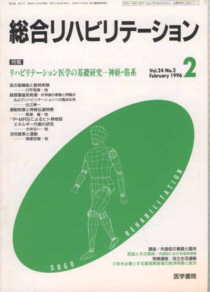


 □実践講座:自立生活運動
□実践講座:自立生活運動
2.介助を必要とする重度障害者の経済保障と就労
重度四肢まひ者の就労問題研究会
清家一雄
『ワーキング・クォーズ』関係者各位
1996年4月9日
清家 一雄
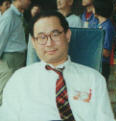
重度四肢まひ者の就労問題研究会・代表
『ワーキング・クォーズ』編集部
"WORKING QUADS" homepage
制作提供
拝啓
時下ますますご清栄のこととお喜び申し上げます。
いつもたいへんお世話になっています。
「介助を必要とする重度障害者の経済保障と就労」が、
医学書院の『総合リハビリテーション』1996年2月号に掲載されました。
その別刷が出来ましたので、送ります。
お時間がありましたら読んでみてください。
何か伝わるものがあれば幸いです。
お体に気をつけてください。
皆様にもよろしくお伝えください。
これからもよろしくお願いします。
敬具


この
「介助を必要とする重度障害者の経済保障と就労」、
(医学書院の『総合リハビリテーション』1996年2月号掲載)
は、
英文プレゼンテーション
in The World at Work of
第18回RI世界会議
in ニュージーランド・オークランド
on September 18, 1996
で、
英文で発表し、
New Zealandは編集発行の
英文論文集に掲載されました。
『総合リハビリテーション』1996年02月号 目次
Sogo Rehabilitation
1996年2月号(第24巻2号)目次
□特集/リハビリテーション医学の基礎研究-神経・筋系
高次脳機能と動物実験
鹿児島大リハ科 川平和美・他
経頭蓋磁気刺激-計測値の意義と問題点およびリハビリテーションへの臨床応用
東海大リハ医学 出江紳一
運動刺激と神経伝達物質
藤田保健衛生大リハ医学 馬場尊・他
P-MRS によるヒト骨格筋エネルギー代謝の研究
国立精神・神経センター武蔵病院理学療法科
大仲功一・他
活性酸素と運動
産業医科大健康科学教室 南里宏樹・他
□巻頭言
(精神)障害者手帳交付について
都立中部総合精神保健福祉センター 村田信男
□講座:失語症の基礎と臨床
2.言語とその意味-失語症における意味理解
東北大高次機能障害学 山鳥重
□実践講座:自立生活運動
2.介助を必要とする重度障害者の経済保障と就労
重度四肢まひ者の就労問題研究会
清家一雄
□研究と報告
急性心筋梗塞回復期における監視型運動療法の効果に関する研究
聖マリアンナ医大リハ部 山田純生・他
アキレス腱切断マウスの腱と筋組織の組織学的変化
広島大保健学科 弓削類・他
□一頁講座:障害者スポーツ
2.身体障害者スポーツの現状と展望(2)
日本身体障害者スポーツ協会
三村一郎
□Sweet Spot:文学に見るリハビリテーション
宇宙飛行士サンチョ・パンサ-「グローバル」という概念
東大医学部精神衛生 高橋正雄
□学会印象記
第11回日本義肢装具学会学術大会
大阪労災病院リハ診療科 川村次郎
□実践講座:自立生活運動
2.介助を必要とする重度障害者の経済保障と就労
重度四肢まひ者の就労問題研究会
清家一雄
1. はじめに-目的
(1)重度四肢まひ者の経済保障と就労問題
著者自身、C5レベルの頸髄損傷による重度四肢まひ者であり、重度障害者であ。1973年7月、高校2年の時、ラグビーの試合中の事故により受傷した。以来、自分自身の問題として、頚髄損傷者を代表例とする重度四肢まひ者の「介助」と「仕事」の問題に取り組んできた。
障害には、視聴覚障害、精神障害、肢体障害、あるいは内部臓器障害といった身体部位別分類がある。一方、機能障害、能力障害、社会的不利といった階層的分類もある。また、障害のこのような分類に“重度障害”という概念を追加するものもある。本論では、重度障害者の中でも、主に、重度四肢まひ者の経済保障と就労についての問題を取扱う。
(2)重度障害者の自立生活とその費用
重度障害者にとっての[社会的]自立生活(Independent Living)の中核は、本人の自由意思による自己決定とそれに対する自己責任である、と考えられる。この自由が実質的に保障されるためには、豊富な選択肢が用意され、かつ利用可能であることが必要である。また、重度障害者の自己決定権を保障するためには、自己決定能力・自己管理能力とならんで、経済的基盤の確保が重要な前提条件となる。
要介助の重度四肢まひ者にとり、経済的基盤の中には、本人の生活費と並んで介助者費用が必要となる。要介助の運転免許取得不可能な重度四肢まひ者にとっては、リフト付タクシー料金なども必要となってくる。視覚障害者では朗読者、聴覚障害者では手話通訳者、要約筆記者の費用などである。住居費用は、障害のあるなしに必要なものであるが、受傷以前に住居取得の場合、受傷後家族と同居の場合は、軽減されるが、病院・施設から退院・退所時、家族からの独立時に非常に大きな問題となる。家族に頼らず、住み込みの介助者を雇う場合には、もう一部屋余分の住居費がかかる、通いの場合には交通費がかかる。
重度障害者が自立生活、とくに社会的自立を得るためには、経済的基盤をどのように獲得するかが重要である。わが国で自立生活運動を展開する場合に、経済保障をどう獲得すべきか。特に、国や地方自治体による保障に加えて、重度障害者の積極的就労を促進して経済保障を得る考え方もある。本論では、これら自立生活運動展開と重度障害者の経済保障および就労問題について、現状と展望を考察することを目的とする。
2. 対象と方法
2.1 対象
頚髄損傷者を代表例とする重度四肢まひ者には知的機能障害はない。しかしその身体的機能障害は、身体障害の中では最重度である。本論では、重度四肢まひという(一次的な障害、WHO・世界保健機構のいうインペアメントimpairment)をもち、移動能力や書字能力などの日常生活動作能力の不足(二次的な障害、ディスアビリティdisability)に苦労している個人たちが、知的生産活動を行い、「生活の質(Quality of Life)」をいかにして改善していくのかを考察する。
著者は、重度四肢まひ者の就労(知的生産活動)の可能性を調査研究する場として、1989年以来、「重度四肢まひ者の就労問題研究会」を主宰してきた。当「研究会」は、重度四肢まひ者の就労の可能性を調査研究を目的とし、四肢まひ当事者自身と専門家による研究の場として活動してきた。日米加の事例の実態調査を行い、社会的背景の日米加比較、ハイテクの活用可能性等の検討を行ってきている。
要介助の運転免許取得不可能な重度四肢まひ者は、社会生活はもとより自宅で家族と生活することさえ困難で、病院に長期滞留する人や施設生活者が少なくない。在宅での生活もきわめて厳しく、公的介助者制度は未整備で、家族依存がほとんどであり、有意義で有償の仕事の機会は、障害を持たない人たちに比較し、ほとんどないような状態である。公務員の障害者職員採用特別枠でさえ、自力通勤可能で介助不要の者との条件があり、重度四肢まひ者の就労問題は未解決のままである。
このような日本の現状の中、「就問研・会報」は、重度四肢まひ者の知的生産活動を取り上げている。要介助の重度四肢まひ者でも、実際に仕事をしている人が、ごく少数ながら現れてきた。就労問題研究会は、実際に働いている人を発掘し、広く知らせている。
「就労問題研究会」は、1989年9月以来、1995年3月までに、不定期ながら10回の会報『ワーキング・クォーズ(WORKING QUADS)』を発行、現在に至っている。『WORKING QUADS』⑨はA4版、124頁+カラー4頁、1000部、特集:自営業と重度四肢まひ者、『WORKING QUADS』⑩はA4版、174頁、1000部、特集1:WINDOWS Ver3.1を利用した知的生産活動環境、特集2:重度四肢まひ者の国際ネットワーク活動である。現在、『WORKING QUADS』①~⑩の編集者は6名(重度四肢まひ者5名)、66名の執筆者(対麻痺者1名。健常者6名、重度四肢まひ者59名)である。
今回、その中から、TO氏、IS氏、TY氏、KY氏、HM氏、FT氏、NS氏の7事例を対象としてとりあげる。選択理由は、『Working Quads』執筆者の中でも、非常に実用的に、実務において、有償の知的生産活動として、零細自営、専門自営(学習塾経営、プログラミング、司法書士)、大規模自営、雇用に関する最先端の事例である。
3. 結果と考察
3.1 結果
3.1.1 重度障害者の経済保障に関する諸制度
重度障害者に対する国や地方自治体による経済保障としては、年金制度として、国民年金障害基礎年金、厚生年金障害年金、共済年金、労災年金などがあり、年金以外の経済保障として厚生省の特別障害者手当、地方自治体の手当などがある。社会保障制度上の包括的なものとしては、生活保護制度がある。
1986年の、国民年金法改正による、年金制度の改革の中で障害基礎年金制度と特別障害者手当が創設された。
障害基礎年金は、被保険者期間中に初診日がある傷病により障害者となったとき、または20歳未満の傷病の発生で障害者となった場合に支給される。支給額は、1級月額81,250円、2級月額65,000円である。(国民年金法)。
「会報」①~⑩の重度四肢まひ寄稿者59名中、自営(零細自営、自由業を含む)28名 雇用11名、学生2名、無職18名である。無年金者は14名である。
3.1.2
[事例1:TO氏:零細自営:ワープロ請負。
[写真]
CASE ONE
Case 1 Mr. T.O., Small-scale self-employment,
the data input and the word processor business in his Home
Photograph
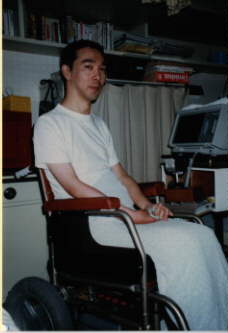
Mr TO. Born in 1962. Male. Acquired his C5 quadriplegia due to an accident, in a
class of physical education as a third year student in prefectural industrial high
school,in 1980. Entered Iwate Workers' Accident Compensation Hospital in 1981.
Entered a nursing home " Yoshihamaso " in 1982. Began to work on the word
processor (NEC 7RA) for a printing office nearby in 1990. Began independent
living after leaving the Nursing Home in May 1992. Got married in May 1992.
Receives a basic pension disability and the special physically handicapped person
allowance. Using mouth sticks, a telephone with speakerphone, a powered hoist,
manual wheelchairs, a powered wheelchair, and a station wagon (his wife drives).
Running his own small business in his home. Data input and the word processor
business are done by using his personal computer, PC9801FA (CPU 486) and the
FAX-Modem. He lives in a private apartment in Morioka City, Iwate and the
attendant person is his wife. He is healthy, and the length of his service is six
years.
CASE TWO
Case 2 Ms. I.S., Professional self-employment,
Management of a private tutoring shcool in her home.
Photograph
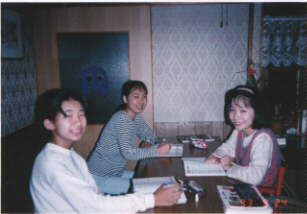
The photograph is a class scenery in her own house. Ms. I.S. is a right edge.
Ms IS. Born in 1956. Female. Entered the English literature faculty of
Seinangakuin University in April, 1975. Acquired her C6 quadriplegia due to a
traffic accident in August 1978. Entered Kyushu Workers' Accident Compensation
Hospital in September 1978. Moved to the Spinal Injuries Center, Japan in
-400-
September 1979. Went back home and returned to the University in April 1980.
Began to tutor junior and senior high students in English at home in June 1980.
Graduated from the University in March 1981. Receives no pension. Receives the
special physically handicapped person allowance. Lives with her family in her own
house and attendant persons are her mother and home helpers . Useing a
telephone with speakerphone, a fax machine, manual wheelchairs, and a word
processor (MS-DOS text file function). The English study progrmmes in her
own house. It is an private lesson of one to two high school and junior high school
students of two hours at a time. She is healthy and the length of her service is
fifteen years. She lives in Munakata County, Fukuoka Prefecture.
CASE THREE
Case 3 Mr. T.Y., Professional self-employment;
Free lance computer programmer and system engineer in his home.
Photograph
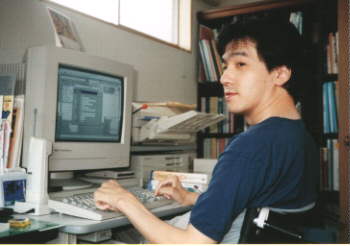
Mr. TY, special running one's own business, and software development of free (programming)
Mr TY. Born in 1958. Male. Entered the department of engineering of Meiji
University in April, 1978. Acquired his C7 left C6 right incomplete quadriplegia due
to a traffic accident in October 1980 when working part-time. Entered Tokyo
Koseinenkin Hospital. Moved to Yutaka Home of Japan Sun Industries in Beppu
City in December 1981. Entered employment joining a company of the Mitsubishi
Corp & Japan Sun Industries Inc. in February 1984. Married on December 2 1985.
Got the qualification "Data Processing 1st grade" in January 1989. Was
determined to returns to hometown in time for his father's death in 1990. Began
to works as a free lance computer programmer and system engineer in October
1991 Receives the Workers' Accident Compensation pension and the special
physically handicapped person allowance. Lives with his wife and two children in
his own house using a manual wheelchair. Drives a remodelled car. Using a
computer NEC "Xt" system (CPU Pentium 166MH), memory 32MB, hard disk
drive 3.1GB, 17 inch display. ISDN telephone line, Terminal Adapter 64KB, MS
Word (WIN), Visual C++ (WIN), MS-C Ver 6.0 (DOS), MASM Ver 5.1 (DOS),
N88BASIC (DOS), ACCESS (WIN), CA-dBFast (WIN). Develops software related
programs to the factory by using the C language, BASIC, and the assembler with
Windows machine Xt. The design and the programming are done in the language
corresponding to the demand of the purchaser. Is healthy, and the length of his
service is twelve years. Works twelve hours a day on the average. Lives in
Nobeoka City, Miyazaki Prefecture.
-401-
CASE FOUR
Case 4 Mr. K.Y.,
Professional Self-Employment, judicial scrivener in his office
Photograph
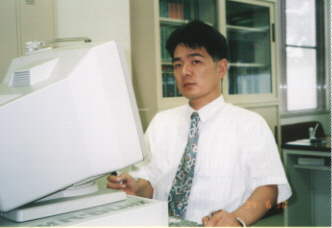
Mr. KY, special running his own business, judicial scrivener
Mr KY. Born in 1962. Male. Acquired his C6-7 quadriplegia due to a sport
accident of Judo and entered the Kyushu Workers' Accident Compensation
Hospital in August, 1979. Discharged from hospital to home and returned to his
high school in April 1980. Entered the law faculty of Kitakyushu University in April
1982. Lived with his parents in an apartment in the vicinity of the university.
Graduated from the master course of law faculty of the University in March 1988.
Got the license of a judicial scrivener in December 1988. Business training began
in the Judicial Scrivener Office in May in 1989; judicial scrivener registration in
June in 1990. Began to manage his "Y office" in Nakatsu City in Oita Prrefecture in
July 1990. Office establishment in July in the same year. Receives a national
basic disability pension and the special physically handicapped person allowance.
Lives with his parents and the attendant person is his mother in his own house. In
his office there are two clerks. Specialises in running his own business as a
judicial scrivener. Using manual wheelchairs, a fax machine, and a Hitachi
personal computer and judicial scrivener business software. Drives a remodelled
car for commuting. Is healthy, and the length of his service is three months of five
years. Lives in Chikujo County, Fukuoka Prefecture.
CASE FIVE
Case 5 Mr. H.M., Large-scale self-employment,
management of his building for rent in his home and his office
President of the company to maintain his building for rent
Photograph
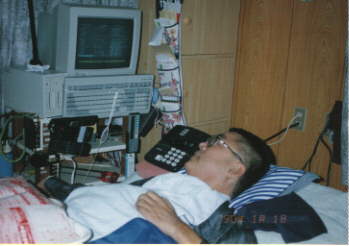
Mr. HM, large-scale running one's own business, building maintain company president
Mr HM. Born in 1938. Male. Entered Law Course of Tokyo University in 1958.
Acquired his C6 quadriplegia due to a car accident, in August, 1959. Discharged
from hospital to his home in 1962. After leaving Tokyo University, tutored at home
and manages parking lots. Established a company in 1968. Left home in the
summer of 1970 at the age of 32 and moved to the house at the coast which his
father had built. Planed to build a building for rent on his father's land close to the
railway station instead of doing the parking lot. Financing is applied to the Housing
Loan Corporation for the building construction capital and the capital of about 70
per cent of the architectural expense 160,000,000 yen could be borrowed.
Negotiated financing on the architectural capital to bank as for the remainder of the
architectural expense. His father offered the construction site as security for the
loan. The building of seven storeys was completed in 1979. Lives by handling the
paid attendant persons in his own house in Japan (spring, summer, autumn) and
the Philippines (winter). Hires a clerk to maintain the building. Using mouth sticks,
a powered hoist, a telephone with speakerphone, a fax machine, manual
wheelchairs, a powered wheelchair with reclining system, one box car with ramp
(his attendant drives), NEC personal computer, PC9801US2 (CPU 386) and
PC9821V7 (CPU, Pentium 75MH), 16MB memory, 500MB HDD, 15 inch display,
-402-
and a modem with Windows 95. Running Koyokosan Inc and 'Green Life
Institution in Japan'. Published two books, The Reviving Buddhism and
A Revived Life. After establishing the company at the age of 29, the length of his
service is 28 years. Is healthy, but was several times hospitalized due to
pneumonia etc. both in Japan and the Philippines. Lives in Kitakyushu City,
Fukuoka Prefecture.
CASE SIX
Case 6 Mr. F.T.,
Employment, reinstatement of the Bureau of Sewage of Fukuoka City
Chubu Sewage Treatment Plant
Photograph
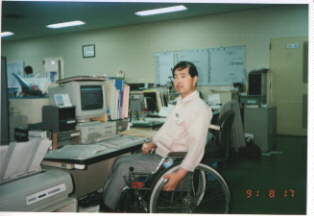
Mr. FT, employment, at his office of the Bureau of Sewage of Fukuoka City,
Chubu Sewage Treatment Plant
Mr FT. Born in 1943. Male. Graduated from the Department of Engineering of
Kyushu University in 1967. Entered employment of the Bureau of Sewage of
Fukuoka City in 1967. Acquired his C7 incomplete quadriplegia due to a traffic
accident while commuting in service of Fukuoka city office in 1985. Entered the
Spinal Injuries Center, Japan. Went back to his own home in 1987. Returned to
the employment of the Bureau of Sewage of Fukuoka City in 1988. Was assigned
to the Chubu Sewage Treatment Plant in 1988. Receives employment income and
Workers' Accident Compensation pension, etc. The mutual aid pension is
stopping. Lives with his family and the attendant person is his wife in his own
house. Using manual wheelchairs and powered hoist in his house. Employment
and reinstatement. Works as an engineer using a computer with Ichitaro, Lotus
123 etc. for making various documents and the data arrangements and explains
about the Chubu Sewage Treatment Plant to visitors. Using a computer
NEC "DA" system (CPU 386), hard disk drive 40MB, 14inch display. In his work,
the personal computer operation is 70 percent. Commuting between the office
and his home is by taxi and by the help of his wife. His wife commutes between
office and home to provide the assistance for meal and .toileting during the day.
She commutes three times a day. He is healthy, and the length of his service is
seven years since being reinstated in December 1988. It is the same working
hours as colleague without disability in the office. Lives in Fukuoka City, Fukuoka
Prefecture.
CASE SEVEN
Case 7 Ms. N.S.,
Employment, Return to Employment of Amagasaki City Junior High-school
Photograph
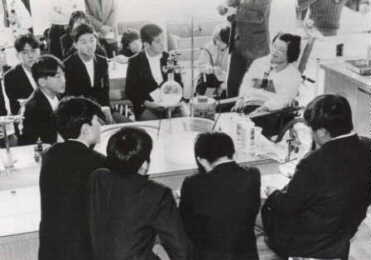
Mr. NS, employment, Amagasaki city teacher reinstatement
Ms NS. Born in 1943. Female. Acquired her C4 quadriplegia due to a ballooning
accident during her overseas travel to Kenya in August 1989. Enteted hospital.
After returning to Japan, entered the Kansai Workers' Accident Compensation
Hospital in September in the same year. Complete weaning from ventilatory support
was in 1990. Left the hospital and moved into a lease apartment house
-403-
in September 1992. Gave class of science open to the public in elementary school
and in junior high school in December in the same year as a lecturer. The
reinstatement wish is submitted to the city educational committee on December
18 1992. The attached hospital medical certificate was conditionally assumed to
be "reinstatement is possible". Amagaaki City Educational Committee and Hyogo
Prefecture Educational Committee notified her of the admission of the
reinstatement wish on February 5 1993. Returned to employment as a Junior High
School science teacher of Amagasaki City on February 8 1993. Training work at
Amagasaki Municipal Education center. As for the content of her work, it is
science education and welfare education. Receives employment income and Workers'
Accident Compensation pension, etc. The Mutual Aid pension is stopping. Lives
with two volunteers in her lease apartment house. Is attended by paid
attendants and volunteers. Using mouth sticks, the Environmental Control
System, manual wheelchairs, and a powered chin control wheelchair with reclining
system, a telephone with speakerphone, and a personal computer PC9801RA
(CPU.386). Is healthy, and the length of her service is three years. Lives in
Amagasaki City, Hyogo Prefecture.
3.2 考察
自立生活運動展開と重度障害者の経済保障および就労問題
重度障害者の生活も、基本的には、市民社会の原理である生活自己責任の原則を排除するものではなく、個人の自助努力を前提とし、自分自身の収入[と扶養義務者の収入]により、個人が自立して生活していくことが原則である。しかし、身体的に最重度の障害をもつ重度四肢まひ者で、特別な資産や能力がない場合、その生活費と介助費用を確保することは非常に困難である。わが国で自立生活運動を展開する場合に、経済保障をどう獲得すべきか、が重要な問題となる。
3.2.1 経済保障
1986年の、国民年金法改正による、年金制度の改革の中で障害基礎年金制度と特別障害者手当が創設されたが、重度四肢まひ者にとって、生活費、住居費、介助サービスを十分にまかなう水準とは言えない。特に要介助の(運転免許取得不可能な)重度四肢まひ者にとって、介助者費用の負担はは非常に厳しく、1995年現在、福岡市の民間付添料金は1日1万円を超える。
介助(者)は、生活の質、就労(生活)を支える基盤である。
NS氏の場合、家族に依存せずマンションでの生活である。C4頚髄損傷者であり、夜間の住み込み介助者の確保が療護施設での生活を回避するための不可欠な条件である。夜間住み込みの介助者を確保できなければ、教壇復帰も、また現在の研修勤務の就労の道も閉ざされてしまう。
日本の社会保障制度では、就労能力のある者は、自分自身の就労収入によって生活することが原則であるが、重度四肢まひ者が介助者費用までも自分で負担し続けることは困難である。高齢者保健福祉十か年戦略(ゴールドプラン)などによる公的ヘルパー制度の整備が緊急の課題である。
3.2.2 就労問題
また、日本の社会保障制度では、就労能力のある者は、自分自身の就労収入によって生活することが原則であることから、特に、国や地方自治体による保障に加えて、重度障害者の積極的就労を促進して経済保障を得る考え方も出てくる。重度障害者=重度四肢まひ者も、就労過程に参加し、収入を得る選択肢の開発が必要とされる。条件が整備され、このことが実現されれば、重度四肢まひ者自身の自立度が向上し、重度四肢まひ者の介助必要量を減少させ、生産性を向上させる工夫、システム、生産環境開発に関する情報が共有されることは、四肢まひ者自身、家族、社会の人々にとり非常に有益なことである。
頚髄損傷者を代表例とする重度四肢まひ者には知的機能障害はない。3.1.2の7名の事例で示されたように、彼らは、個人的な資質、資産、努力に依存しながらも、考え、工夫し、知恵を出して、生活を改善し、活動・就業の幅を広げてきた。通勤負担を伴わない自営業が多いが、零細自営(ワープロ入力請負等:TO氏)から、大規模自営(貸しビル経営:HM氏、賃貸マンション経営等)、専門自営(学習塾経営:IS氏、プログラミング:TY氏、司法書士:KY氏、翻訳等)への道を切り拓いてきている。運転免許取得不可能な重度四肢まひ者の雇用労働への就労の実例として、FT氏(「ある幼稚園児の一日」、4号)、NS氏(尼崎市中学教諭、「復職できました」、9号)、の原稿が掲載された。
著者は、1985年~86年に、ミスタードーナツ障害者リーダー米国留学研修派遣事業で、米国の在宅介助システムと自立生活運動の調査研究を米国で行った(広げよう愛の輪運動基金、日本障害者リハビリテーション協会)。また、1990年、トヨタ財団の研究助成を得て、「高度技術社会の進展と外傷性重度四肢麻痺者の生産活動参加過程に関する日米比較研究およびハイテクの活用による新しい可能性に関する研究」というテーマで、調査研究する機会を得た。ハイテクの導入では日本も米国に遅れていないが、専門職、公的機関の管理職、自立生活センターの管理職などの重度四肢まひ者は少ない。アメリカでは重度四肢麻痺者が知的生産の過程に参加している例は少なくないが、その背景には、ハイテクを利用したさまざまな支援システムと並んで、障害アメリカ人法(ADA)にみられるような障害者差別を認めないという社会的合意も大きな力となっていると思われる。今後の課題である。
4.むすび
頚髄損傷者を代表例とする重度四肢まひ者には知的機能障害はない。知的能力が残っている重度四肢まひ者が、療護施設、特別養護老人ホーム、病院などで生活することは建設的でないし、生活の質の点からも問題があり、何より選択肢がないことは疑問である。
重度四肢まひ者でも、介助サービス、住居、移動、教育などの条件が整備されれば、働くことも含んだ自立生活が可能である。
条件が整備され、このことが実現されれば、重度四肢まひ者自身の自立度が向上し、重度四肢まひ者の介助必要量を減少させ、生産性を向上させる工夫、システム、生産環境開発に関する情報が共有されることは、四肢まひ者自身、家族、社会の人々にとり非常に有益なことである。一般の重度四肢まひ者が普通の努力での、一般雇用関係における復職・新規採用、専門職・管理職への就労、就業可能な自営業(在宅、自宅外の仕事場)を可能とする教育、就職の機会、人的介助(公的制度)、物的資源による支援システムを考案し、できれば開発を行いたい、と考える。
1995年度、「就労問題研究会」は、丸紅基金助成事業「障害者の職域拡大につながる活動のための重度四肢まひ執筆者ネットワーク形成とデータベース構築事業」として、「就問研・会報」寄稿者を中心に、情報ネットワークを形成し、介助必要で運転免許取得不可能な重度四肢まひ者の就労・就業(知的生産活動)を実現するために役立つ情報のデータベースを構築(和文英文の)し、日本国内外の重度四肢まひ者、家族、関係者・専門家、その他の人々の役に立てる事業を遂行している。
頚髄損傷者を代表例とする重度四肢まひ者の「介助」と「仕事」の問題は、著者が受傷以来の取り組んできたテーマである。重度四肢まひ者も、交流する人たちは立ち直りが早いように感じられる。情報を提供、定着させる重要性を感じている。「就労問題研究会」および『WORKING QUADS』では、重度四肢まひ者の就労問題に関して、これからも、問題点の提示、役に立つ情報を提供できるよう、継続して活動する、大きな視野を持つ情報ネットワークを構築していきたいと思っている。
著者および「就労問題研究会」の調査研究、事業に協力援助された広げよう愛の輪運動基金、日本障害者リハビリテーション協会、トヨタ財団、丸紅基金に深く感謝します。
文献
)赤津隆:脊髄損傷リハビリテーションの20年,リハビリテーション医学 20:255-260,1983.
) DeJong G : Independent living ; From social movement to analytic paradigm. Arch. Phys. Med. Rehabil 60: 435-446, 1979.
) DeJong G : Attendant care as a prototype independent living service. Arch. Phys. Med. Rehabil 60: 477-482, 1979.
)堀勝洋:『社会保障法総論』、東京大学出版会
)今井銀四郎:脊髄損傷ハンドブック.技報堂出版,1978.
)今井銀四郎:脊髄損傷ハンドブック.改訂版,新地書房,1988.
) Madox S, Menter R : The Management of High Quadriplegia', 'Vol. 1: Hogan B.
In : Complihensive Neurologic Rehabilitation ( ed by Whiteneck G, Adler C, Carter RE, et al , Demos Publications, New York, 1989,pp.319-323 )
) Laurie G :Summary of independent living. pp.18-19, P.A.C. Meeting on April, 1985.
)津山直一:序.標準リハビリテーション医学,津山直一監,医学書院,1986.
)松井和子:身体障害者雇用政策に関する一考察.社会保障研究 19:414-431,1984.
) 松井和子:在宅頸髄損傷者.東京都神経科学総合研究所,1987,
)緒方甫,脊髄損傷のリハビリテーション.標準リハビリテーション医学,津山直一監,医学書院,1986.
)大橋正洋:リハビリテーションのニューフロンティア.メディカル・ヒューマニティ 5,57-61,1991.
)大熊由紀子:「寝たきり老人」のいる国いない国-真の豊かさへの挑戦.p.81,ぶどう社,1990,
) Roessler R: Foundation of the vocational rehabilitation process. 2nd ed,1983,Austin, Texas, pp.205-218.
)清家一雄:アメリカの人々ともう一つの選択肢.自立へのはばたき-障害者リーダー米国留学研修派遣報告1985,日本障害者リハビリテーション協会・広げよう愛の輪運動基金,1986.
) 清家一雄:頸髄損傷者の米国留学生活.在宅頸髄損傷者,松井和子編,pp.132-151,東京都神経科学総合研究所,1987.
) 清家一雄、「頚髄損傷者と生産活動」①~⑧、リハ工学カンファレンス講演論文集、 日本リハビリテーション工学協会、1989~1995
) 清家一雄:脊髄損傷者の就労など社会的到達目標:脊髄損傷(ポリオを含む)による重度四肢まひ者の生産活動参加過程に関する日米比較研究とハイテクの活用による新しい可能性.脊椎脊髄ジャーナル,Vol.5、No.7,pp495-506,三輪書店,1992.
) 清家一雄:介助を必要とする重度四肢まひ者の就業-「重度四肢まひ者の就労問題研究会」の活動と寄稿原稿を素材として.RE Vol.7. №1,日本リハビリテーション工学協会,pp.39-56,1992.
) 清家一雄:日米のC4頚髄損傷者と職業リハビリテーション-高度技術社会の進展と外傷性重度四肢まひ者の知的生産活動-、職業リハビリテーション第6巻、日本職業リハビリテーション学会,pp.61-68,1993
) 清家一雄他、『 WORKING QUADS 』№9、1993.12、A4・124頁、重度四肢まひ者の就問研
) 清家一雄他、『 WORKING QUADS 』№10、1995.3、A4・174頁、重度四肢まひ者の就問研
)上田敏:リハビリテーションを考える,青木書店,1983.
)上田:リハビリテーション医学序説,標準リハビリテーション医学,津山直一監,医学書院,1986.
1995年10月30日 福岡
++++++++++++++++++++++++++++++++++++++++++++++++++
ご意見、ご批判も多いと思います。
ご感想、ご助言をお聞かせいただければ幸いです。
1996年02月日、福岡にて
清家 一雄
重度四肢まひ者の就労問題研究会; 代表
『ワーキング・クォーズ』編集部
"WORKING QUADS" HomePage 制作提供
http://www4.justnet.ne.jp/~seike/
http://www.asahi-net.or.jp/~YS2K-SIK/
seike@ma4.justnet.ne.jp
YS2K-SIK@asahi-net.or.jp
〒810- 福岡市中央区大手門
Tel +81-92-735-
Fax +81-92-735-

Kazuo Seike ( seike@ma4.justnet.ne.jp )
http://www4.justnet.ne.jp/~seike/
"WORKING QUADS" HomePage
e-mail to the "WORKING QUADS" HomePage